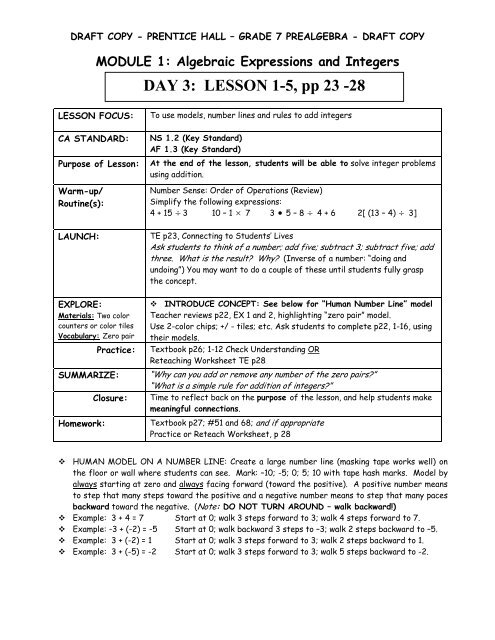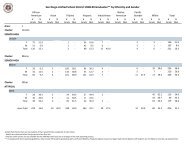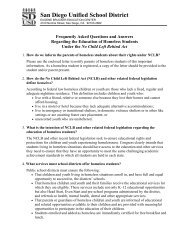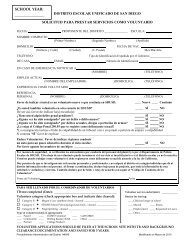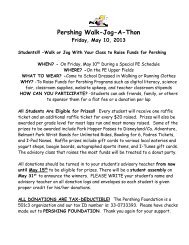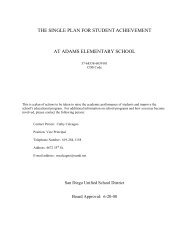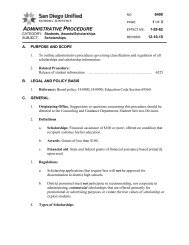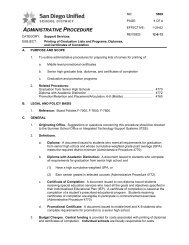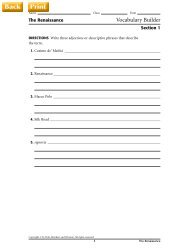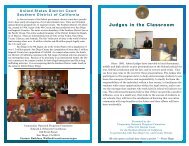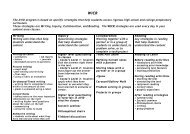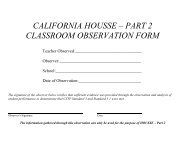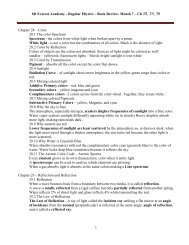PRE-ALGEBRA GRADE 7 Module 1 - San Diego City Schools
PRE-ALGEBRA GRADE 7 Module 1 - San Diego City Schools
PRE-ALGEBRA GRADE 7 Module 1 - San Diego City Schools
You also want an ePaper? Increase the reach of your titles
YUMPU automatically turns print PDFs into web optimized ePapers that Google loves.
DRAFT COPY - <strong>PRE</strong>NTICE HALL – <strong>GRADE</strong> 7 <strong>PRE</strong><strong>ALGEBRA</strong> - DRAFT COPY<br />
MODULE 1: Algebraic Expressions and Integers<br />
DAY 3: LESSON 1-5, pp 23 -28<br />
LESSON FOCUS:<br />
CA STANDARD:<br />
Purpose of Lesson:<br />
Warm-up/<br />
Routine(s):<br />
LAUNCH:<br />
EXPLORE:<br />
Materials: Two color<br />
counters or color tiles<br />
Vocabulary: Zero pair<br />
Practice:<br />
SUMMARIZE:<br />
Homework:<br />
Closure:<br />
To use models, number lines and rules to add integers<br />
NS 1.2 (Key Standard)<br />
AF 1.3 (Key Standard)<br />
At the end of the lesson, students will be able to solve integer problems<br />
using addition.<br />
Number Sense: Order of Operations (Review)<br />
Simplify the following expressions:<br />
4 + 15 3 10 – 1 7 3 5 – 8 4 + 6 2[ (13 – 4) 3]<br />
TE p23, Connecting to Students’ Lives<br />
Ask students to think of a number; add five; subtract 3; subtract five; add<br />
three. What is the result? Why? (Inverse of a number: “doing and<br />
undoing”) You may want to do a couple of these until students fully grasp<br />
the concept.<br />
INTRODUCE CONCEPT: See below for “Human Number Line” model<br />
Teacher reviews p22, EX 1 and 2, highlighting “zero pair” model.<br />
Use 2-color chips; +/ - tiles; etc. Ask students to complete p22, 1-16, using<br />
their models.<br />
Textbook p26; 1-12 Check Understanding OR<br />
Reteaching Worksheet TE p28<br />
“Why can you add or remove any number of the zero pairs?”<br />
“What is a simple rule for addition of integers?”<br />
Time to reflect back on the purpose of the lesson, and help students make<br />
meaningful connections.<br />
Textbook p27; #51 and 68; and if appropriate<br />
Practice or Reteach Worksheet, p 28<br />
HUMAN MODEL ON A NUMBER LINE: Create a large number line (masking tape works well) on<br />
the floor or wall where students can see. Mark: –10; -5; 0; 5; 10 with tape hash marks. Model by<br />
always starting at zero and always facing forward (toward the positive). A positive number means<br />
to step that many steps toward the positive and a negative number means to step that many paces<br />
backward toward the negative. (Note: DO NOT TURN AROUND – walk backward!)<br />
Example: 3 + 4 = 7 Start at 0; walk 3 steps forward to 3; walk 4 steps forward to 7.<br />
Example: -3 + (-2) = -5 Start at 0; walk backward 3 steps to –3; walk 2 steps backward to –5.<br />
Example: 3 + (-2) = 1 Start at 0; walk 3 steps forward to 3; walk 2 steps backward to 1.<br />
Example: 3 + (-5) = -2 Start at 0; walk 3 steps forward to 3; walk 5 steps backward to -2.


